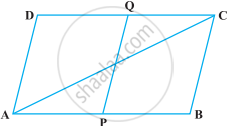Advertisements
Advertisements
Question
In a parallelogram ABCD, AB = 10 cm and AD = 6 cm. The bisector of ∠A meets DC in E. AE and BC produced meet at F. Find the length of CF.
Solution

Given, AB = 10 cm, AD = 6 cm
DC = AB = 10 cm and AD = BC = 6 cm
Given, bisector of ∠A intersects DE at E and BC produced at F.
Now, drawing PF || CD.
From the figure,
CD || FP and CF || DP
PDCF is a parallelogram.
And AB || FP and AP || BF
ABFP is also a parallelogram
In ΔAPF and ΔABF
∠APF = ∠ABF ...(Opposite angles of a parallelogram are equal)
AF = AF ...(Common side)
∠PAF = ∠AFB ...(Alternate angles)
ΔAPF ≅ ΔABF ...(By ASA congruence criterion)
AB = AP ...(CPCT)
AB = AD + DP
= AD + CF ...(Since DCFP is a parallelogram)
∴ CF = AB – AD
= (10 – 6) cm
= 4 cm
APPEARS IN
RELATED QUESTIONS
Diagonals of a parallelogram `square`WXYZ intersect each other at point O. If ∠XYZ = 135° then what is the measure of ∠XWZ and ∠YZW?
If l(OY)= 5 cm then l(WY)= ?

The diagonals AC and BD of a parallelogram ABCD intersect each other at the point O. If ∠DAC = 32º and ∠AOB = 70º, then ∠DBC is equal to ______.
E and F are points on diagonal AC of a parallelogram ABCD such that AE = CF. Show that BFDE is a parallelogram.
Points P and Q have been taken on opposite sides AB and CD, respectively of a parallelogram ABCD such that AP = CQ (Figure). Show that AC and PQ bisect each other.

A diagonal of a parallelogram bisects one of its angles. Show that it is a rhombus.
ABCD is a rectangle in which diagonal BD bisects ∠B. Show that ABCD is a square.
If diagonals of a quadrilateral bisect each other, it must be a parallelogram.
Two sticks each of length 5 cm are crossing each other such that they bisect each other. What shape is formed by joining their endpoints? Give reason.
Two sticks each of length 7 cm are crossing each other such that they bisect each other at right angles. What shape is formed by joining their end points? Give reason.
